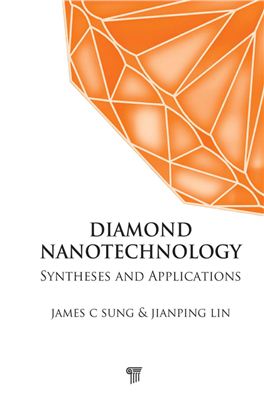Pan Stanford Publishing Pte. Ltd. , 2010, -258p. (анг. язык)
Carbon is uniquely capable to form bonds of polymers (sp1), metals (sp2), and ceramics (sp3). As a result, carbon becomes the backbone of organic materials, fast conductors, and superhard ceramics. Diamond is not only the prevalent superabrasives (1000 tons consumed every year), but also the supreme semiconductor with figure of merits many times of silicon. In fact, silicon, with larger atoms arranged in diamond structure, can be viewed as weak diamondmaterial.
Diamondpossesses unsurpassed hardness thermal conductivity and sound speed. Consequently, diamond can be the best heat spreader for cooling integrated circuits and high power laser diodes, and the ideal vibrator for tweeter diaphragms and surface acoustic wave (SAW) filters.
The evolution of human civilizations depends on the advancement of material technology. However, up to now, the industry has produced materials by easy access. This straight forward path will eventually lead to diamond, the dream material for fantasy applications.
Diamond has the most extreme properties. Some of them have been exploited, but more potential applications are developed, such as the fastest computation possible with using quantum bits of diamond (e.g. NV).We are entering diamond age with numerous novel diamond gadgets to be unveiled in this century. Thus, we may encounter diamond SAWfilters, diamond LED, diamond solar cells, diamond IR detectors, diamond front panel displays, etc.
In this book, we introduced many facets of diamond, from its cosmic origin to high-pressure synthesis, fromCVDdiamond films to dynamite nanodiamonds. As diamond is also the most common solid in the universe at large, the cosmic presence and biological connections of nanodiamonds are proposed.We have also included amorphous diamond coating for tribological applications and gem diamond growth for jewelry industry.
Carbon is uniquely capable to form bonds of polymers (sp1), metals (sp2), and ceramics (sp3). As a result, carbon becomes the backbone of organic materials, fast conductors, and superhard ceramics. Diamond is not only the prevalent superabrasives (1000 tons consumed every year), but also the supreme semiconductor with figure of merits many times of silicon. In fact, silicon, with larger atoms arranged in diamond structure, can be viewed as weak diamondmaterial.
Diamondpossesses unsurpassed hardness thermal conductivity and sound speed. Consequently, diamond can be the best heat spreader for cooling integrated circuits and high power laser diodes, and the ideal vibrator for tweeter diaphragms and surface acoustic wave (SAW) filters.
The evolution of human civilizations depends on the advancement of material technology. However, up to now, the industry has produced materials by easy access. This straight forward path will eventually lead to diamond, the dream material for fantasy applications.
Diamond has the most extreme properties. Some of them have been exploited, but more potential applications are developed, such as the fastest computation possible with using quantum bits of diamond (e.g. NV).We are entering diamond age with numerous novel diamond gadgets to be unveiled in this century. Thus, we may encounter diamond SAWfilters, diamond LED, diamond solar cells, diamond IR detectors, diamond front panel displays, etc.
In this book, we introduced many facets of diamond, from its cosmic origin to high-pressure synthesis, fromCVDdiamond films to dynamite nanodiamonds. As diamond is also the most common solid in the universe at large, the cosmic presence and biological connections of nanodiamonds are proposed.We have also included amorphous diamond coating for tribological applications and gem diamond growth for jewelry industry.

